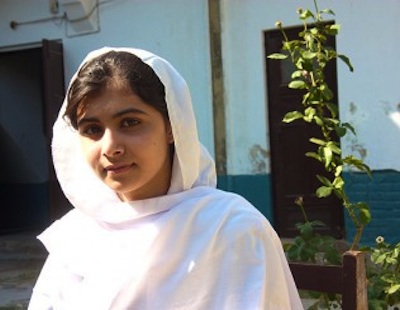By: Summer Yasmin
She first appeared to the world as “Gul Makai”, Corn Flower; a writer for the BBC Urdu Blog. It was 2009, the Taliban were blowing up girl’s schools across Pakistan’s Swat Valley. A seventh grader then, she agreed to be the voice of civilian Pakistan and wrote about her daily life as the “First Battle of Swat” raged around her. With a position as chairperson of the District Child Assembly Swat, a nomination for the International Children’s Peace Prize, an attack on her life by the Taliban, triumphant survival and another nomination for the Nobel Peace Prize, the world now knows her by her real name: Malala Yousafzai.
In October, 2012 after Malala suffered a bullet to her head and shoulder by Taliban gunmen, her story and mission hit global proportions. She has become an international icon, representing the 32 million girls that are denied basic education. With the world coming together to support her cause, one may assume that this could be the turning point for Pakistan’s “education crisis” (as stated by the Pakistani government in 2011). However the problem of education, particularly girl’s education in Pakistan is as deep rooted as the Swat Valley itself. What Malala was experiencing back in 2009 and subsequently blogging about was not just a Taliban problem, it was, and still is a government problem as well.
For the many rural areas of Pakistan where literacy rates are at their lowest in the country, education for girls is a concept that goes against the grain. These regions differ from urban city centers like Karachi, Lahore and Islamabad in that education is not only denied because the resources are not present but also because it is considered unnecessary and even wrong. In theory these medieval evaluations can be written off as the biased of a few but the problem is that these few also happen to hold as much power and sway in the region as does the government itself. In places like the Swat Valley, where Malala grew up, local landlords have a strong and permanent standing. The Pakistani government concedes to them in order to control the region. Education (of anyone, male or female) is a direct threat to this tribal system, as people who are educated will be hard to keep under rule. Thus, to establish a system of education in these areas is extremely challenging and so far the Pakistani government has done little to promote or offer initiatives for education here.
Pakistan’s education crisis is therefore, a twofold one with both socio-cultural and political factors at play. But Malala Yousafzai and everything she represents may still be the answer. Firstly, the 15 year old activist has become so entrenched in the hearts and minds of people that many organizations around the globe have been inspired to initiate tangible interventions. The United Nations Foundation, Girl up and many other organizations and individuals have come together to form the “Malala Fund” on behalf of Malala and her family. “The fund will support education and empowerment of girls in Pakistan and worldwide by providing grants to civil society organizations and individuals focused on education. It will be advised by a committee comprising of education experts and entrepreneurs as well as Malala – when she is well enough and her family”, said Alyse Nelson, President and CEO of Vital Voices. With this financial brawn, Pakistan’s education system has a chance at a future. The extra resources would mean better quality schools, well trained teachers and relevant curriculum, all necessary in encouraging rural families to overcome their fear and reservations and send their daughters to school. But these measures, as promising as they are, will not develop into long term solutions without the support of Pakistan’s government. President Asif Ali Zardari, at a recent youth conference said “we are fighting a negative state of mind and the youth of this country is a challenge to that mindset.” Although Zardari has condemned the attack on Malala and voiced support for women’s education in Pakistan, it remains to be seen whether actions will follow up his words. Speaking in Azerbaijan on Tuesday, he said: “The Taliban attack on the 14-year-old girl, who from the age of 11 was involved in the struggle for education for girls, is an attack on all girls in Pakistan, an attack on education, and on all civilized people.”
External initiatives like the Malala Fund will only be successful when backed internally, by solid government policies. Literacy rates for women in Pakistan have been consistently lower than that of males and literacy in rural areas of the country are significantly lower compared to urban zones. This shows that Pakistan has not been upholding its constitutional promise of basic education for all citizens. In this, the international pressure that came as a result of the assassination attempt on Malala must remain prominent. Just as the world found a beacon of light in Malala Yousafzai, this fuse must now extend to the whole of Pakistan’s female population as well as young women worldwide who also want what Malala wants. Malala Yousafzai must not become a forgotten poster girl before her dream is fulfilled. We must confront this issue with the same resilience as Malala herself “They will not stop me. I will get my education if it is in home, school or any place.




















Comments